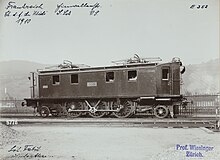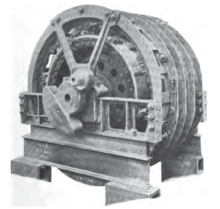Midi E 3301
| Midi E 3300 SBB CFF FFS Be 2/5 | ||
|---|---|---|
Power supply Overhead line | | |
| Electric system/s | Single phase AC, 12/15 kV, 16⅔ Hz. | |
| Current pickup(s) | 2 pantographs | |
| Traction motors | Two Deri repulsion motors | |
| Performance figures | |
|---|---|
| Maximum speed | 75 km/h |
| Power output | 660 kW (continuous) 736 kW (one hour) |
| Career | |
|---|---|
| Nicknames | Viktor |
Midi E 3301 was a prototype electric locomotive of Class E 3300 designed for the Chemins de fer du Midi, France. Because of poor performance, it was refused by the Compagnie du Midi and was re-deployed to Swiss railways. On 1 May 1919, it was classified Fb 2/5 11001 and, in 1920, it became experimental locomotive Be 2/5 11001 of the Swiss Federal Railways (SBB).
Overview
Many lines of the Midi network being mountain lines, the company began an electrification programme in 1909. The system chosen was single phase alternating current at 12 kV and 16⅔ Hz.

Six prototype locomotives were ordered for the Perpignan - Villefranche-de-Conflent line. They were:[1]
- E 3001 from Thomson and General Electric
- E 3101 from Henschel
- E 3201 from Westinghouse, later SNCF 1C1 3900
- E 3301 from Brown-Boveri and SLM Winterthur
- E 3401 from Ateliers du Nord et de l'Est
- E 3501 from Schneider
The E 3301 locomotive was expected to perform the following tasks:
- Haul a 400-ton train on a 2.2% gradient
- Haul a 300-ton train at 40 km/h on a 2.2% gradient
- Haul a 100-ton train at 60 km/h on a 2.2% gradient
- Be equipped with an electric brake for descents
Technical details


The companies SLM Winterthur and Brown-Boveri built the E3301 locomotive in 1910-1911. Power was provided by two large Déri repulsion motors that filled almost the entire engine room. The speed and direction of the motors were controlled by brush-shifting, allowing the train to start without jolting. The motors were powered at 1,250 V by two traction transformers connected in parallel. The power of the motors was transmitted to the central axle by two inclined rods, without gears, then to the other drive axles by coupling rods.
Trials
The E 3301, equipped with auxiliary transformer windings for 15 kV operation, was tested on the Spiez - Frutigen line. During these tests, some design faults became apparent. On 18 February 1912, the locomotive was transferred to Perpignan and trials continued until 16 August 1912. The locomotive was unable to deliver the required performance, as was the case for two other machines. Another gave partial satisfaction, but only E 3201 was fully satisfactory. The Midi also ordered railcars E ABD 1 to 30, which became Class Z 4900 of the SNCF.
Modifications and axle drive testing

The two transformers were replaced by a single one behind the first driver's cab, balancing the traction motors, and with a tap changer for power control.
Service in Switzerland
The modified locomotive was first tested on the
Until 1919, the machine was used to haul passenger trains on the Thun–Spiez line. On 1 May 1919 it entered permanently the service of the SBB under the number Fb 2/5 10001. From the energizing of the line Bern–Spiez on 7 July 1919, it began to haul passenger trains. By the end of 1919, it had travelled 24,500 kilometres. In 1920, when it became Be 2/5 11001, it travelled a further 5,500 kilometres and, by 1921, the total was 35,300 kilometres. Around this time, the locomotive was nicknamed Viktor.
SBB were receiving new and better locomotives, so they looked for a new assignment for Viktor. On 1 June 1922, it was assigned to the
In 1925, Viktor was transferred to the Lucerne depot and hauled trains to
On 15 May 1928, the locomotive Be 3/5 12201 resumed its services and Viktor was relegated to shunting duties at Zürich depot. It covered only about 7,000 kilometres in 1928. In 1929, the mileage dropped to 592 km.
Final years
In 1929, Viktor was converted into a self-propelled welding wagon Xe 1/5 n° 99999 which later became XTe 1/5 n° 99999. It was withdrawn on 17 September 1937 and scrapped in December 1937.
References
- ^ Similar tests with a mixed arrangement of axle drives were also tried later on the SBB-CFF-FFS Ae 4/8.
- ISBN 9780486412474.
- Davies, John. Chemins de fer du Midi and Chemins de fer de Paris à Orleans Locomotive List 1840–1938. Woodbridge, Queensland: Dr. John Davies. p. 56. ISBN 0-9585541-0-2.
Further reading
- Yves Machefert-Tassin, Fernand Nouvion, Jean Woimant, Histoire de la traction électrique. tome I : des origines à 1940, Éditions La Vie du Rail, 1980, 561p. (ISBN 2902808224)
- Lucien-Maurice Vilain, Évolution du matériel moteur et roulant de la Cie du Midi : 19855 à 1934 (fusion P.O. Midi), Édition Picador, 1979, 286p. (ISBN 2902653034)

